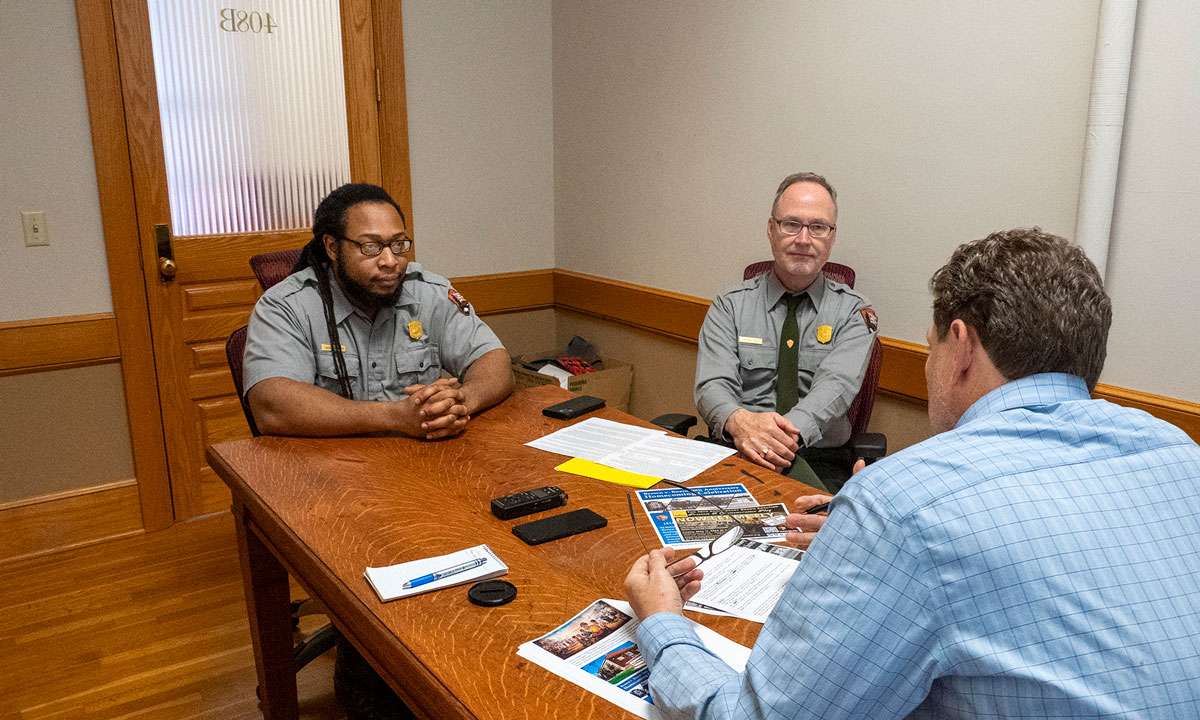Topeka Celebrating 70th Anniversary of Brown v. Board Of Education Decision
Washburn University to present a play, National Park Service to host reunion.

Get stories like this delivered straight to your inbox. Sign up for The 74 Newsletter
TOPEKA — Brown v. Board of Education National Historical Park interpreter Jeff Tully says Kansas entered the union as an anti-slavery state in 1861, but in less than two decades the Kansas Legislature passed a law allowing cities of more than 15,000 residents to segregate elementary schools.
The law applicable to Topeka’s youngest, most impressionable children stayed on the books from 1879 until the 1950s.
“This was the state that wrote in our Constitution, ‘We forbid slavery,’ ” Tully said on the Kansas Reflector podcast. “Yet, 20 years later, we’ll start segregating African American kids in primary schools.”
Lawson Nwakudo, another National Park Service interpreter at the national historical site in the Monroe Elementary School, said that peculiar state law and the excellent Black-only schools in Topeka drew the interest of the NAACP, which was forming a legal strategy that sought to demonstrate to justices of the U.S. Supreme Court the harm inherent in a system of “separate but equal” schools and the necessity of disassembling segregated classrooms across the nation.
“Not only were these educators incredible, but they’re actually more educated than their white counterparts,” Nwakudo said of Topeka’s Black elementary school teachers. “The reason why the NAACP wanted to focus on Kansas, on Topeka, was because there was that level of equality. If they could prove there’s something inherently wrong with a place like Kansas … that would mean that there’s something inherently wrong with everywhere else.”
The consolidated court case, known as Brown v. Board of Education, resulted in the Supreme Court’s unanimous decision May 17, 1954, that declared state-sanctioned segregation of public schools to be a violation of the equal protection clause of the 14th Amendment to the U.S. Constitution.
To celebrate the 70th anniversary of one of the century’s most significant court decisions, Washburn University in Topeka will present the play “Now Let Me Fly” at 7 p.m. May 17 in White Concert Hall. It examines the journey of heroes and heroines in the legal fight for equality in education. Admission is free with online ticket registration at www.70thanniversarybrowncoalition.org or by calling 785-506-7768.
“There are many characters, many people who were involved with the Brown decision,” Nwakudo said. “This play gives you basically a feeling as to what that was like, and what their lives are like moving through and a little bit after the Brown case.”
The parents in Kansas, Delaware, Virginia, South Carolina and Washington, D.C., who signed on as plaintiffs in what evolved into the Brown v. Board case placed themselves and their children in harm’s way, he said. The lead plaintiff was Oliver Brown, who had a daughter eager to enroll in the Topeka school closest to her home. She was denied access and was required to attend a segregated Black school further from home.
Nwakudo said the stakes were higher for other plaintiffs than they were in Topeka.
“There are some people who are being threatened and other people had their houses burned down. Whereas in Kansas, there still was possibly of an economic threat where your jobs can be threatened. That’s partially why 12 of the 13 complainants were housewives,” Nwakudo said.
Tully said the Brown v. Board of Education National Historical Site organized a homecoming celebration for former students, staff and teachers at Topeka’s historically Black elementary schools from 10 a.m. to 3 p.m. May 18 at the park’s headquarters in the former Monroe Elementary School. The invitees include those with ties to Monroe, but also to Buchanan, McKinley and Washington elementary schools in Topeka.
“At 12:52 p.m. on May 17, 1954, nine Supreme Court judges unanimously said ‘separate but equal’ was inherently unequal,” he said. “We thought Monroe would be the natural place to have this homecoming of sorts.”
The day’s program will include a roundtable discussion among former students from all four schools, followed by a sit-down lunch (registration for the meal is closed), musical entertainment and the taking of class pictures on the front porch of Monroe Elementary. There will be family and group activities on the north lawn. At any point during the day, visitors can contribute their stories and memories to an oral history project and the Kansas State Historical Society will be available to take digital images of documents and memorabilia related to the Topeka schools.
Nwakudo said the transition to integrated schools produced violence and all sorts of maneuvering to delay implementation of the Supreme Court’s orders.
“That is a major uplift for a lot of places, especially in the South, where these children could step away from these one-room shacks that were their schools. No electricity and no indoor plumbing,” he said. “There was a quite a bit of resistance. Places like Tennessee put forth a 12-year plan to desegregate their schools. Virginia tried to resist in any way they could, and actually ended up closing down a lot of their schools across the state.”
He said his message to visitors to the National Historical Park, especially school children, was that they had “power to make a positive change in our lives, just like their predecessors did. We can draw knowledge and strength from those past experiences, to galvanize ourselves to do more to do better.”
Tully said the National Park Service site south of the Kansas Capitol was among 428 National Park units in the United States. The site in Topeka measured barely 1 acre — a far cry from the 2.2 million acres of the Yellowstone National Park and the 1.2 million acres of the Grand Canyon National Park.
“But what happened in a building in Topeka, Kansas, along with four other court cases around the United States, was probably, in many scholars’ opinion, the single most important 20th century Supreme Court decision,” he said.
Kansas Reflector is part of States Newsroom, a nonprofit news network supported by grants and a coalition of donors as a 501c(3) public charity. Kansas Reflector maintains editorial independence. Contact Editor Sherman Smith for questions: [email protected]. Follow Kansas Reflector on Facebook and Twitter.
Get stories like these delivered straight to your inbox. Sign up for The 74 Newsletter

;)